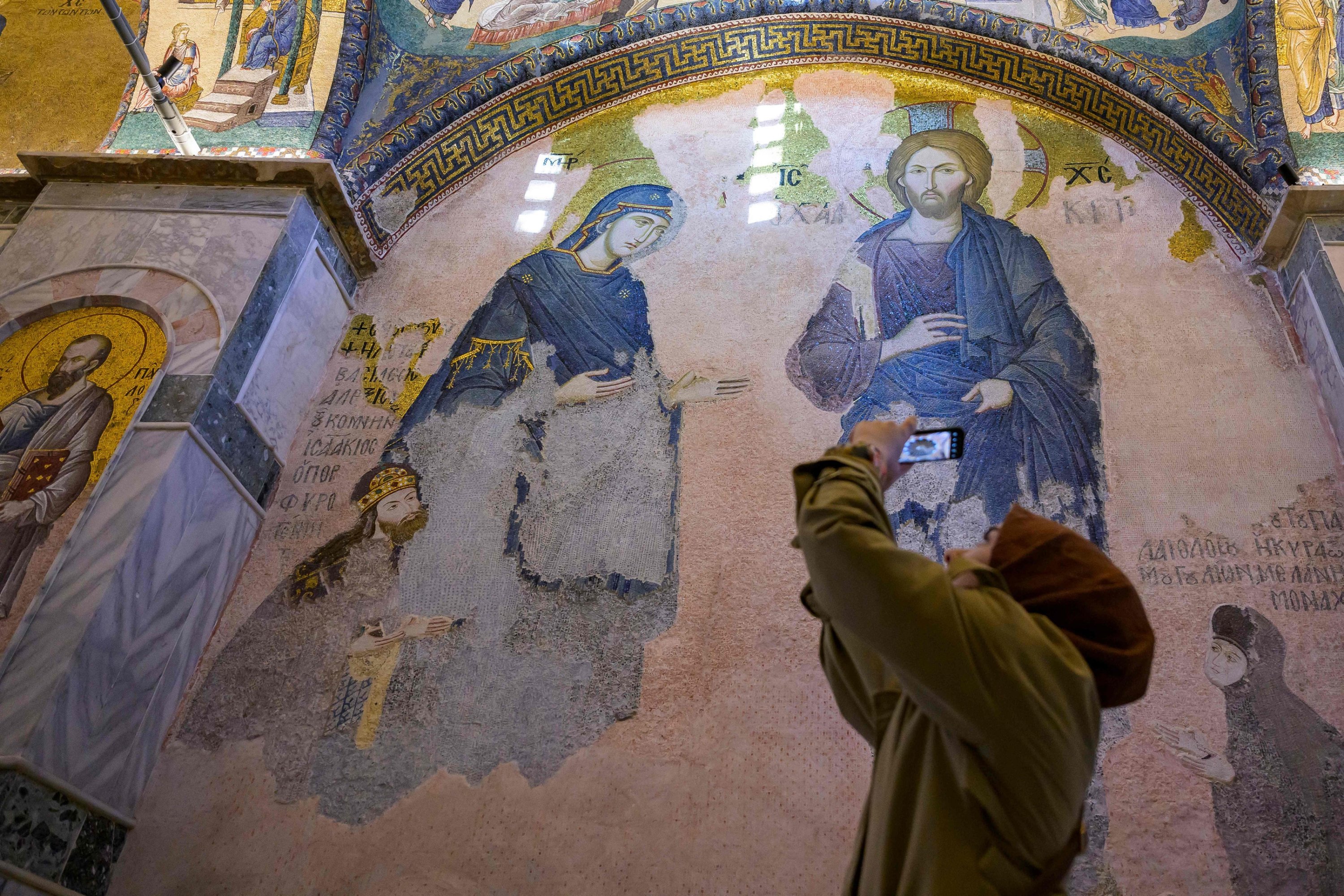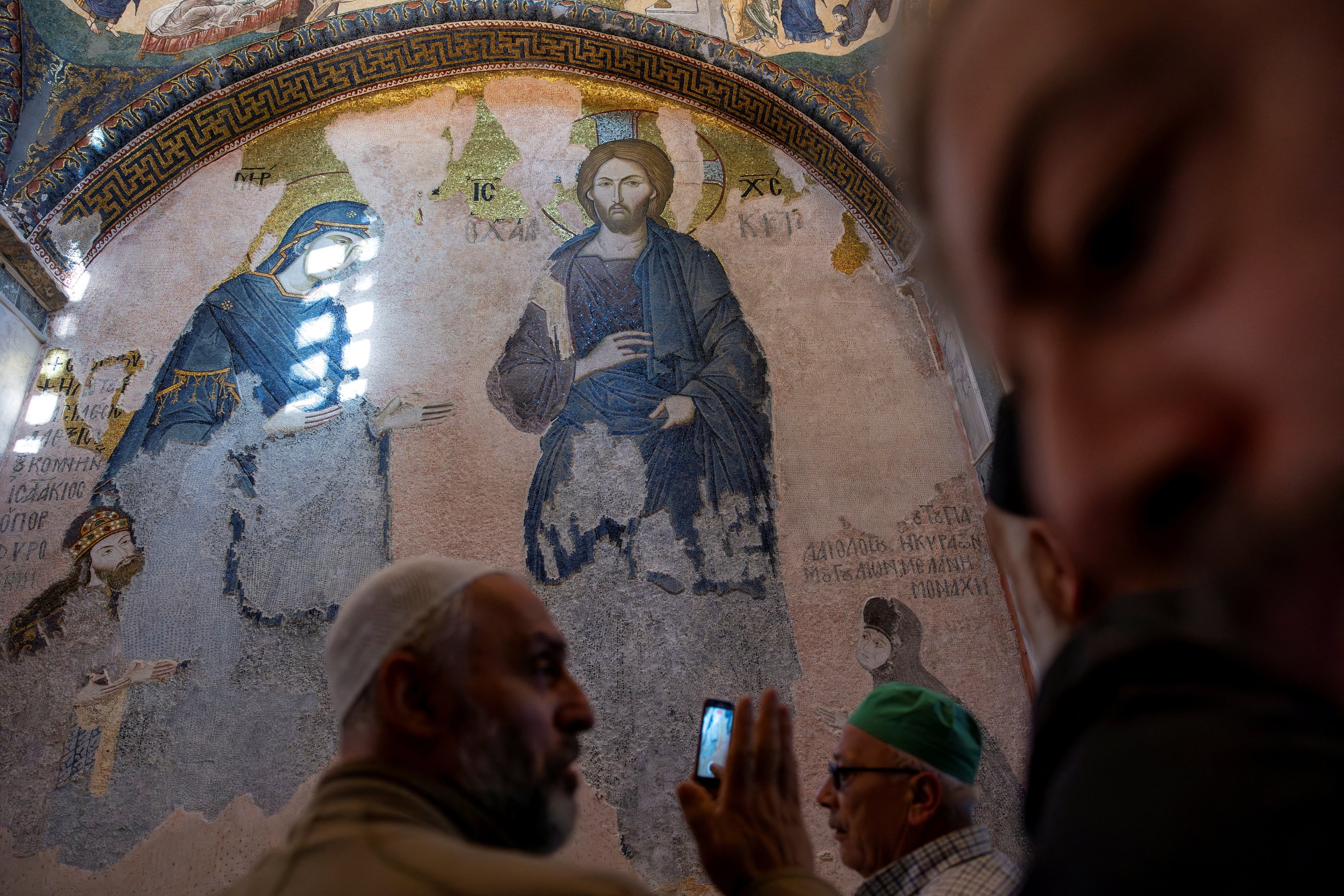© Turkuvaz Haberleşme ve Yayıncılık 2026
The Kariye Mosque in Istanbul, owned by the General Directorate of Foundations of the Ministry of Culture and Tourism and converted into a mosque by the Presidential Decree dated Aug. 21, 2020, has been reopened for worship as both local and foreign visitors showed keen interest.
The mosque, also known as Kariye Camii in Turkish, originally served as a medieval Greek Orthodox church as the Chora Church. Transitioning predominantly into a mosque from the 16th century onward, it resides in the Edirnekapı neighborhood within Istanbul's Fatih district. Its popularity stems from the remarkable Late Byzantine mosaics and frescoes adorning its interior.
The name "kariye," which means "village" in Turkish, finds its roots in the ancient Greek word "khora," signifying "in the fields" or "in the countryside." This transformation occurred as the old church and monastery stood beyond former Constantinople's Theodosian walls, which were erected between 408 and 450 A.D. Despite its geographic connotations, the presence of the word "khora" alongside the names of Jesus and Mary in the church's mosaics suggests a deeper, mystical significance.
One of the frescoes is the icon, the theological conception "Jesus the Pantocrator." This is the central mosaic that looks down from above a quartet of precisely cut marble pieces, arranged with symmetrical precision. Above, layers of semiprecious, gilded and colored stones in the mosaic create a three-dimensional effect with vivid colors and proportional accuracy, depicting legendary religious figures. Despite the dim medieval interior, the whites and blues of the mosaic stand out with aesthetic dynamism. Visitors, regardless of their beliefs, find themselves captivated by Jesus' Zeus-like demeanor, reflecting artistic prowess.

The intricately shaded garments and emotive facial expressions of the figures, alongside depictions of notable individuals, including Metochites and St. Mary of the Mongols, add depth to the experience.
Also, Jesus is shown triumphing over death through the resurrection of Adam and Eve. This victory is portrayed on each side of the chapel's arch, where Jesus performs miracles of raising the dead.
Moving to the western part, the focus shifts to the theme of incarnation. Here, a dome adorned with medallions features the virgin and child surrounded by angels and Byzantine hymnographers. These hymnographers are depicted on the dome's pendentives, composing hymns that honor the virgin and emphasize her role in salvation.
"The Kariye Mosque is one of the most interesting monuments of Istanbul and one of our multi-layered structures. We have been aware of the existence of this structure probably since the sixth century during the Byzantine period. This structure was renovated multiple times throughout the entire Byzantine period in the 11th, 12th and 14th centuries. Between 1316 and 1321, a statesman, scientist and literary figure named Theodore Metokhites ordered extensive renovation of this structure, adding many impressive extensions and additional units around it. He also arranged a section of it as a mausoleum for himself," art history expert and member of the science committee Hayri Fehmi Yılmaz said.
"He also ordered an extensive study of paintings to depict the lives of Jesus and Mary inside the structure. In this regard, it is one of the most intriguing monuments of the Byzantine world. After the conquest, this structure, which was neglected for a while, was converted into a mosque by Atik Ali Pasha in 1509. The pasha transformed this building akin to his personal transformation. He turned this structure, which was the church of a Byzantine monastery, into a mosque. Then it was used as a mosque throughout the Ottoman Empire. However, some of the mosaics and frescoes inside the building remained uncovered during the Ottoman period. Travelers who visited the structure in the 16th and 17th centuries always described some of the depictions they saw inside. For this, it is important in terms of civilization history. Just as the paintings are important for Byzantine culture, the preservation process of this structure and the ability of the artworks to survive are also interesting for the Ottoman Empire," he also said.

"In 1945, a new decision was made and large-scale projects were implemented to uncover all the mosaics and frescoes inside the building. A restoration was carried out here for about 12 years. After the restoration, which was completed at the end of 12 years, the structure was opened to visitors as a museum. Roughly, restoration took another 12 years. At the end of a process starting in 2012, it is completed and now it is again dual-functional. One part is used for worship and the other for visits. Our Ministry of Culture and Tourism, with great effort and an extraordinary budget, has made such a project to extend the life of this structure. Now this magnificent monument has been gifted back to Istanbul. For this we are very fortunate," he added.
A tourist, Mary Simmons, who visited the mosque, expressed her admiration for the mosaics in the structure, said: "I really loved the narratives. The artistic works are very creative. Mosques are highly valued in this country. There are many different perspectives on creation, life and worship. You have a beautiful city that encompasses all of these aspects."
Traveler John Roberts also commented: "This place is very beautiful, a historical building. The mosaics are dazzling. All religious denominations need to be together. I am very happy to see that the building is being looked after and that everything inside is being secured. Everything in the mosque is very beautiful."

Minister of Culture and Tourism Mehmet Nuri Ersoy spoke at the opening of the mosque, highlighting 201 works restored by the General Directorate of Foundations: "In the last 22 years, we have restored about 5,450 works with an expenditure of approximately TL 8 billion ($247.85 million). Only in the last two years, the repairs of 119 foundation cultural assets, including Istanbul Chora Museum, Hz. Cabir Mosque, Beyazıt Madrasa, Beyazıt Imperial Pavilion, Kasımpaşa Mevlevi Lodge, Sivas Divriği Grand Mosque and Istanbul Terra Santa Church, listed in the UNESCO World Heritage List, have been completed. Many places of worship damaged in the Feb. 6 earthquakes have also been repaired."
He emphasized that kindness, compassion and solidarity are at the core of the foundation institution, which is one of the very important values of belief, thought and culture.
Ersoy stated that the nation has shown gratitude to its ancestors who have preserved foundations for centuries, and the presence of hospitals, fountains, baths, libraries and many other works serving today in many parts of Türkiye is evidence of this loyalty.
